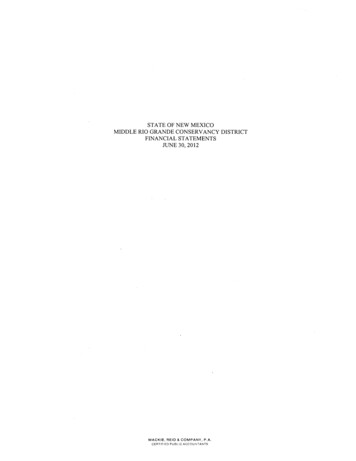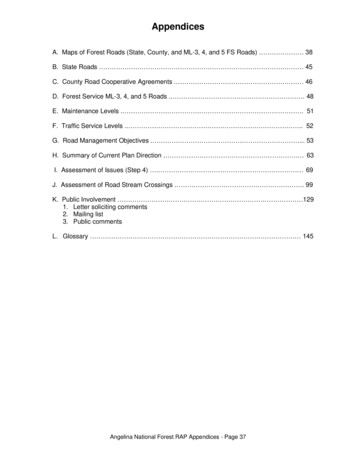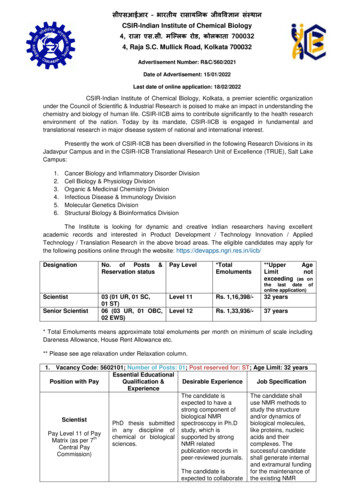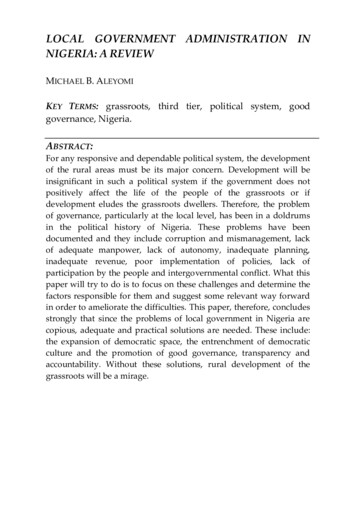
Transcription
Office of the New York State ComptrollerDivision of Local Government and School AccountabilityAccounting andReporting ManualCounties, Cities, Towns and VillagesSoil and Water Conservation DistrictsLibrariesThomas P. DiNapoliARMState Comptroller
For additional copies of this report contact:Comptroller’s Press Office110 State Street, 15th floorAlbany, New York 12236(518) 474-4015or email us:localgov@osc.state.ny.uswww.osc.state.ny.usTo be removed from our mailing list:In an effort to reduce the cost of printing, if you would like to have your nameremoved from our mailing list or if your present address has changed, contact theComptroller’s Press Office at (518) 474-4015 orOffice of the State Comptroller, 110 State Street, 15th Floor, Albany, NY 12236.Date of Issue: January 2009Revised January 2011Reprinted January 2016
Table of ContentsPart 1 — Accounting and ReportingChapter 1 — Introduction.3Chapter 2 — Basic Governmental Accounting Principles.6Chapter 3 — Measurement Focus and Basis of Accounting.12Chapter 4 — Funds and Supplemental Schedules.15Chapter 5 — Classification and Coding.18Chapter 6 — Budgeting.22Chapter 7 — Defining the Financial Reporting Entity.27Chapter 8 — Financial Reporting.36Chapter 9 — GASB Statement No. 34.38Chapter 10 — Sample Journal Entries.42Budget Entries.43Real Property Tax Entries.46Revenue Entries.62Expenditures and Encumbrance Entries.68Accrued Liabilities Entries.71Prepaid Expense Entries.71Judgments and Claims Entries.72Capital Projects Fund Entries.74Indebtedness Entries.78Petty Cash and Departmental Cash Fund Entries.84Reserve Entries.85Chapter 11 — Soil and Water Conservation Districts.88Chapter 12 — Libraries.92General Ledger Codes.92Revenue Codes.94Expenditure Codes.95Table of Contents
Part II — ReferencesGeneral Ledger Account Codes.97Definitions.107Revenue Account Codes.117Definitions .137Expenditure Account Codes.161Definitions.173Terminology.190Useful Links:.215OSC Central Office Listing.216Regional Office Listing.217Table of Contents
Chapter 1 — IntroductionThe Office of the State Comptroller (OSC) has compiled this manual as a comprehensiveaccounting guide for local officials and others interested in accounting by local governments inNew York State. It provides an overview of generally accepted governmental accounting andfinancial reporting principles, and OSC’s interpretations of such principles, wherepronouncements are silent or do not address problems common among jurisdictions within NewYork State.The basic responsibility for oversight of local governments by the State Comptroller is containedin the State Constitution and Article 3 of the General Municipal Law (GML). Among other things,the State Comptroller has authority to: perform audits (GML, Sections 33, 34, 35), prescribeinformation to be included in annual financial reports (GML, Sections 30, 31, 32), prescribe auniform system of accounts (GML, Section 36), and prepare an annual report to the State Legislature(GML, Section 37).Since the late 1970’s, there have been increasing demands on a national level for standardizationof accounting and financial reporting practices. The fiscal crisis in certain cities, increasinggovernmental spending and needs of the investment community and grantors were a driving forcebehind these changes.In 1977, OSC made a commitment to prescribe accounting systems which conform to GenerallyAccepted Accounting Principles (GAAP). OSC prescribes a Uniform Systems of Accounts pursuantto General Municipal Law, Section 36. The System of Accounts provides for a standard chart ofaccounts and fund structure that is the basis for the uniform annual financial reports required to befiled with the State Comptroller pursuant to General Municipal Law, Section 30.Generally Accepted Accounting Principles for Governmental UnitsGenerally Accepted Accounting Principles (GAAP) are uniform minimum standards of andguidelines to financial accounting and reporting. They are the framework within which financialtransactions are recorded and reported resulting in financial statements that provide comparabilitybetween governmental entities, consistency between accounting periods and reliability for internaland external users of financial statements.Since GAAP for local governments is not static but evolving, the Office of the State Comptroller isinvolved in such activities as monitoring and responding to proposed pronouncements; amendingthe Accounting Systems when appropriate in light of new or revised standards; and assisting localofficials in understanding and implementing GAAP through conferences, workshops and seminars.This manual is an example of this activity.A brief overview of the history of standard setting for private enterprises and for government ishelpful in understanding the sources of GAAP for governments. The first formal efforts to establishGAAP for private enterprises began in 1930 in response to the financial difficulties experiencedduring the Great Depression. Over the years, the American Institute of Certified Public Accountants(AICPA) established GAAP. In 1973, the Financial Accounting Standards Board (FASB) wasChapter 1 Introduction - 3
formed. Since 1973, FASB has prescribed GAAP for commercial and non-profit organizations.FASB operates under the auspices of the Financial Accounting Foundation (FAF), an independentnon-profit foundation.GAAP for state and local governments were originally sponsored by the Municipal Finance OfficersAssociation (MFOA), now known as the Government Finance Officers Association (GFOA),through a group known as the National Committee on Municipal Accounting (NCMA). Aftersome years, this committee was replaced by another MFOA-sponsored group, the NationalCommittee on Governmental Accounting, which itself was eventually expanded and renamed theNational Council on Governmental Accounting (NCGA). The MFOA’s guidance was incorporatedinto various editions of a publication that came to be known commonly as the “blue book.” Thefirst edition was published in 1934. The third edition published in 1968 inaugurated the format stillused today in the current edition. In 1974, the AICPA issued their accounting and auditing guide,Audits of State and Local Governmental Units (ASLGU), which stated that the AICPA deemed the1968 Blue Book to be GAAP for governmental units. In the late 1970’s, partly in response to thefiscal crisis in New York City and several other cities, the NCGA began to issue statements andinterpretations. Eventually, the NCGA decided that these pronouncements, rather than the bluebook, should be authoritative. Consequently, later editions of the blue book are not GAAP, butmerely illustrate what is common practice. As mentioned earlier, private-sector standard settingwas eventually transferred from the AICPA to the FAF. Developments in the public sector took avery similar course. In 1984, the responsibility of setting GAAP for state and local governmentswas transferred from the NCGA to the Governmental Accounting Standards Board (GASB). Likethe FASB, the GASB functions under the auspices of the FAF.In short, the following have been the standard setting bodies for GAAP for state and localgovernments:National Committee on Municipal AccountingNational Committee on Governmental AccountingNational Council on Governmental AccountingGovernmental Accounting Standards Board1934-19481948-19741974-19841984-PresentThe GASB is the highest, but not the sole, source of GAAP for state and local governments.When accounting issues are not covered by GASB guidance, guidance from the American Instituteof CPAs (AICPA), Government Finance Officers Association (GFOA), the Financial AccountingStandards Board (FASB) and other sources is used following a prescribed order.4 - Accounting and Reporting Manual
The following is the “hierarchy” of GAAP:GAAP HierarchyLevel *GASBAICPALevel 1Statements andInterpretationsLevel 2Technical BulletinsLevel 3Emerging Issues Task Accounting StandardsForce ConsensusExecutive CommitteePositions(AcSEC) PracticeBulletin (Specificto Government andcleared by GASB)Level 4ImplementationGuidesOther SourcesConcept StatementsOtherAudit and AccountingGuides/Statementsof Positions(SOPs) (Specificto Government andcleared by GASB)Audit Guides/SOPs (Specific toGovernments, but Notcleared by GASB)Widely recognized andprevalent practiceAccounting Literature* The GAAP hierarchy is established by Statement on Auditing Standards (SAS) No. 69, TheMeaning of “Present Fairly in Conformity with Generally Accepted Accounting Principles”in the Independent Auditor’s Report, issued by the American Institute of Certified PublicAccountants in 1992.Chapter 2 provides an explanation of the Basic Governmental Accounting Principles.Chapter 1 Introduction - 5
Chapter 2 — Basic Governmental Accounting PrinciplesGOVERNMENTAL ACCOUNTING PRINCIPLES:The following are basic principles of accounting and reporting applicable to fund based accountingfor local governments:Accounting and Reporting CapabilitiesFund Accounting SystemsFund TypesNumber of FundsReporting Capital AssetsValuation of Capital AssetsDepreciation and Impairment of Capital AssetsReporting Long-Term LiabilitiesMeasurement Focus and Basis of AccountingBudgeting, Budgetary Control and Budgetary ReportingTransfers, Revenues, Expenditures, and Expense Account ClassificationCommon Terminology and ClassificationInterim and Annual Financial ReportsPrinciple — Accounting and Reporting CapabilitiesPurpose:Explains the requirements for accounting records and reporting.Principle:A governmental accounting system must make it possible both:(a) to present fairly and with full disclosure the funds and activities of the governmental unitin conformity with generally accepted accounting principles; and(b) to determine and demonstrate compliance with financial-related legal and contractualprovisions.Reference: GASB Codification Section 1200In New York State there are few, if any, provisions of general statutory law that conflict withGAAP. However, if conflict does exist, financial statements must be prepared in conformance withGAAP. This does not mean that two accounting systems should be maintained. Books of accountshould be maintained on a legal-compliance basis, but should include sufficient additional reportsto permit GAAP-based reporting.6 - Accounting and Reporting Manual
Principle — Fund Accounting SystemsPurpose: Explains funds and their structure.Principle:Governmental accounting systems should be organized and operated on a fund basis. A fund isdefined as a fiscal and accounting entity with a self-balancing set of accounts recording cash andother financial resources, together with all related liabilities and residual equity or balances, andchanges therein, which are segregated for the purpose of carrying on specific activities or attainingcertain objectives in accordance with special regulations, restrictions or limitations.Reference: GASB Codification Section 1300Principle — Fund TypesPurpose: Explains the types of funds and the account groups.Principle:There are three categories of funds used in governmental accounting: Governmental Funds,Proprietary Funds and Fiduciary Funds.Reference: GASB Codification Section 1300Governmental Funds account for most governmental functions.The General Fund accounts for all financial resources except those required to be accounted forin another fund.Special Revenue Funds account for the proceeds of specific revenue sources that are legallyrestricted to expenditures for a specific purpose.Capital Projects Funds account for financial resources to be used for the acquisition or constructionof major capital facilities.Debt Service Funds account for the accumulation of resources for, and the payment of, generallong term debt principal and interest.Permanent Funds account for resources that are legally restricted to the extent that only earnings,not principal, may be used for purposes that benefit the government or its citizenry. These nonexpendable trusts were previously accounted for in the trust and agency fund. Expendable truststhat benefit the government are accounted for as miscellaneous Special Revenue Funds (CM).Proprietary Funds account for a government’s ongoing activities that are similar to thosefound in the private sector.Chapter 2 Basic Governmental Accounting Principles - 7
Enterprise Funds account for operations (a) that are financed and operated in a manner similarto private business where the intent of the governing body is that the cost (expenses, includingdepreciation) of providing goods or services to the general public on a continuing basis be financedand recovered primarily through user charges; or (b) where the governing body has decided thatperiodic determination of revenues earned, expenses incurred, and/or net income is appropriate forcapital maintenance, public policy, management control, accountability, or other purposes.Internal Service Funds account for the financing of goods or services provided by one departmentor agency to other departments or agencies of the governmental unit, or to other governmentalunits, on a cost-reimbursement basis.Fiduciary Funds account for assets held by a governmental unit in a trustee or agentcapacity.Pension Trust Funds account for funds that are required to be held for members and beneficiariesof pension plans or other employee benefits plans.Agency Funds account for funds held purely in a custodial capacity.Private-Purpose Trust Funds account for all other trust arrangements under which principal andincome benefit individuals, private organizations or other governments. These were previouslynon-expendable and expendable trust funds.Supplemental schedules will be used in the annual financial report (AUD) to the State Comptrollerto account for non-current governmental assets and non-current governmental liabilities.Principle — Number of FundsPurpose: Explains the criteria upon which the number of funds is determined.Principle:Governmental units should establish and maintain those funds required by law and sound financialadministration. Only the minimum number of funds consistent with legal and operating requirementsshould be established because unnecessary funds result in inflexibility, undue complexity, andinefficient financial administration.Reference: GASB Codification Section 1300Principle — Reporting Capital AssetsPurpose: Clarify requirements.Principle:At the fund - financial statement level, capital assets are not reported in governmental funds butare reported in proprietary and fiduciary funds. In NYS, government fund capital assets will beaccounted for and reported in the schedule for Non-Current Governmental Assets.8 - Accounting and Reporting Manual
Principle — Valuation of Capital AssetsPurpose: Explains the requirements for recording capital assets.Principle:Capital assets should be reported at historical cost or, if the cost is not practicably determinable,at estimated cost. Donated fixed assets should be recorded at their estimated fair value at the timereceived, plus ancillary charges, if any.Reference: GASB Codification Section 1400Principle — Depreciation and Impairment of Capital AssetsPurpose: Explains the purpose and basis for depreciation.Principle:Depreciation of capital assets should not be reported in the accounts of governmental funds.Depreciation of capital assets accounted for in a proprietary fund should be recorded in the accountsof that fund. Depreciation is also recognized in those trust funds where expenses, net income, and/or capital maintenance is measured.Reference: GASB Codification Section 1400Principle — Reporting Long-Term LiabilitiesPurpose: Clarify requirements.Principle:There are three categories of long-term liabilities:1. Long-term liabilities related to proprietary funds should be reported in those funds.2. Long-term liabilities related to fiduciary funds should be reported in those funds.3. All other long-term liabilities not reported in 1 or 2 will be accounted for and reported in theschedule of Non-Current Governmental Liabilities.Principle — Measurement Focus and Basis of AccountingPurpose: Explains the accounting basis and its applicability to the various funds.Principle:In fund financial statements, the modified accrual or accrual basis of accounting, as appropriate,should be used in measuring financial position and operating results.Chapter 2 Basic Governmental Accounting Principles - 9
a. Financial statements for governmental funds should be presented using the current financialresources measurement focus and the modified accrual basis of accounting. Revenues shouldbe recognized in the accounting period in which they become available and measurable.Expenditures should be recognized in the accounting period in which the fund liability isincurred, if measurable, except for unmatured interest on general long-term liabilities, whichshould be recognized when due.b. Proprietary fund statements of net assets and revenues, expenses, and changes in fund netassets should be presented using the economic resources measurement focus and the accrualbasis of accounting.c. Financial statements of fiduciary funds should be reported using the economic resourcesmeasurement focus and the accrual basis of accounting.d. Transfers should be reported in the accounting period in which the interfund receivable andpayable arise.Reference: GASB Codification Section 1600Principle — Budgeting, Budgetary Control and Budgetary ReportingPurpose:records.Clarifies requirements for budgets and their relationship to the accountingPrinciple: An annual budget(s) should be adopted by every governmental unit. The accounting system should provide the basis for appropriate budgetary control.Reference: GASB Codification Sections 1700 and 2400In New York State, general statutory law requires political subdivisions to establish appropriationsas a means of providing control over amounts that may be expended. In addition, revenues otherthan real property taxes must be estimated as a means of determining the amount of real propertytaxes to be levied. OSC requires budgets for funds classified as general, special revenue, capitalprojects, debt service and proprietary. At a minimum, revenues must be controlled by source andexpenditures/expenses by functional unit and basic object of expenditure/expense. The books ofaccounts must establish budgetary control at the level of detail contained in the original budget andas modified by the governing board during the fiscal year.Principle — Transfers, Revenues, Expenditures, and Expense AccountClassificationPurpose: Identifies the accounting classifications of transactions.10 - Accounting and Reporting Manual
Principle:Governmental fund revenue should be classified by fund and source. Expenditures should beclassified by fund, function (or program), organization unit, activity, character, and principalclasses of objects.Proprietary fund revenues and expenses should be classified in essentially the same manner asthose of similar business organizations, functions, or activities.Interfund transfers and proceeds of general long-term debt issues should be classified separatelyfrom fund revenues and expenditures or expenses.Reference: GASB Codification Section 1800Principle — Common Terminology and ClassificationPurpose: Provides the ability to compare planned and actual activities for all funds.Principle:A common terminology and classification should be used consistently throughout the budget, theaccounts, and the financial reports of each fund.Reference: GASB Codification Section 1800Principle — Interim and Annual Financial ReportsPurpose: Clarifies financial reporting requirements.Principle:Appropriate interim financial statements and other pertinent information should be prepared tofacilitate management control of financial operations, legislative oversight, and, where necessaryor desired, for external reporting purposes.A comprehensive annual financial report should be prepared and published (optional in NYS).The categories of statements and reports listed above establish national standards of financialreporting. They should not be confused with the legal requirement of municipal corporationsreporting to the Office of the State Comptroller as required by Sections 30, 31 and 32 of theGeneral Municipal Law.Chapter 2 Basic Governmental Accounting Principles - 11
Chapter 3 — Measurement Focus and Basis of AccountingGovernmental funds differ from proprietary funds. These differences have been described asdifferences of measurement focus and differences of basis of accounting. Measurement focusrefers to what is measured and reported in a fund’s operating statement while basis of accountingdetermines when a transaction or event is recognized in these funds.MEASUREMENT FOCUSGovernmental FundsAre there more or less resources that can bespent in the near future as a result of eventsand transactions of the period?Proprietary FundsIs the fund better or worse off economicallyas a result of events and transactions of theperiod?Flow of current financial resources- (modified accrual)Flow of economic resources- (accrual)Increase in spendable resources- revenues or other financing sourcesEvents and transactions that improve theeconomic positions- revenues or gainsDecrease in spendable resources- expenditures and other financing usesEvents and transactions that diminisheconomic positions- expenses or lossesSituations which illustrate the difference between the two measurement focuses are as follows:1. Receipt of long-term debt proceeds:Governmental FundsIncrease in resources availableDR CashCR Other Financing SourcesProprietary FundsNo economic improvementDR CashCR Bonds Payable2. Repayment of principal on long-term debt:Governmental FundsProprietary FundsDecrease in spendable resourcesEconomic position not diminishedDR ExpenditureDR Bonds PayableCR CashCR CashIn both instances, there would be an expenditure/expense for interest due on the debt.12 - Accounting and Reporting Manual
3. Capital acquisition:Governmental FundsDecrease in spendable resourcesDR ExpenditureCR Cash4. Exhaustion of capital assets:Governmental FundsNo effect on spendable resourcesDepreciation is not recognized5. Deferrals and Amortization:Governmental FundsDecrease in spendable resourcesDR ExpenditureCR CashProprietary FundsEconomic position not diminishedDR EquipmentCR CashProprietary FundsEconomic position diminishedDR Depreciation ExpenseCR Accumulated DepreciationProprietary FundsEconomic position diminished only by theexpense for the benefited periodDR Deferred ChargeCR CashDR Amorization ExpenseCR Deferred Charge(Entire disbursement recognized in currentperiod.)(Expense allocated over entire period ofbenefit.)BASIS OF ACCOUNTINGAn entity’s accounting basis determines when transactions and economic events are reflected in itsfinancial statements.Cash Basis:Under the cash basis of accounting, revenues and expenditures are recognized as cash is receivedand disbursed. The balance sheet reflects only a balance of cash and fund balance while activitystatements simply are a summary of cash receipts and disbursements.Accrual Basis:Under the accrual basis of accounting, most transactions are recorded when they occur, regardlessof when cash is received or disbursed.Chapter 3 Measurement Focus and Basis of Accounting - 13
Modified Accrual:Under the modified accrual basis of accounting, revenues and other financial resources arerecognized when they become susceptible to accrual, that is when they become both measurableand available to finance expenditures of the current period. Expenditures are recognized when thefund liability is incurred, with certain exceptions.Governmental FundsProprietary FundsModified Accrual — cash flow must occur Full Accrual — Revenue/gain or expense/losswithin a short-enough period to affect current recognized when they occur regardless of cashspendable resources. Revenues must be both flow.measurable and available and expenditures aregenerally recognized when they are expected todraw upon current spendable resources.1. Billing for services rendered:Governmental FundsDR ReceivableCR RevenueCR Deferred RevenueProprietary FundsDR ReceivableCR RevenueOnly the amount available to finance liabilities Entire revenue recognized in period inof the current period would be recognized aswhich service was provided. The timing ofrevenues.collections is not relevant.2. Employees earn vacation leave that will be taken sometime in the future:Governmental FundsProprietary FundsNo expenditureDR ExpenseCR Accrued LiabilityLeave would only be recognized as anexpenditure to the extent it is expected to beliquidated with current spendable resources.The liability has been incurred.EQUITYThe difference between assets and liabilities:Governmental FundsProprietary FundsFund BalanceNet AssetsReservedInvested in capital assets, net of related debtUnreservedRestrictedUnrestricted14 - Accounting and Reporting Manual
Chapter 4 — Funds and Supplemental SchedulesThe following funds and supplemental schedules are available for use by local governments. Asstated in the Number of Funds Principle in Chapter 2, local governments should establish andmaintain only the minimum number of funds consistent with legal and operating requirements.Governmental Funds:General (A) — the principal operating fund and includes all operations not required to be recordedin a separate fund.General Fund Town-Outside-Village (B) — used only by towns which contain a village torecord transactions which are required by statute to be charged to the area of the town outside thevillage.Special Grant (CD) — accounts for Federal and State grants such as Community DevelopmentBlock Grants, the Workforce Investment Act and the Section 8 Rental Assistance Program.Miscellaneous (Refuse, Parking, Recreation, Transportation, and Miscellaneous)(C ) — accounts for those revenues that are legally restricted to expenditures for specific purposes.The CM should also be used to account for trusts that benefit the local government where principaland interest may be expended.County Road (County Only) (D) — required by Highway Law §114 and accounts for salariesand expenditures of the county highway superintendent’s office, maintenance of county roads andbridges, snow removal and construction and reconstruction of county roads.Highway (Town Only) (DA/DB) — established pursuant to Highway Law §141 and accounts forrevenues and expenditures for highway purposes. The major areas of expenditures are repairs andimprovements, bridges, machinery, and snow and miscellaneous. For towns without a village, alltransactions would be recorded in the Highway Town-Wide Fund. For those towns with villages,Highway Law §277 requires that expenditures for repairs and improvement
For additional copies of this report contact: Comptroller's Press Office 110 State Street, 15th floor Albany, New York 12236 (518) 474-4015











